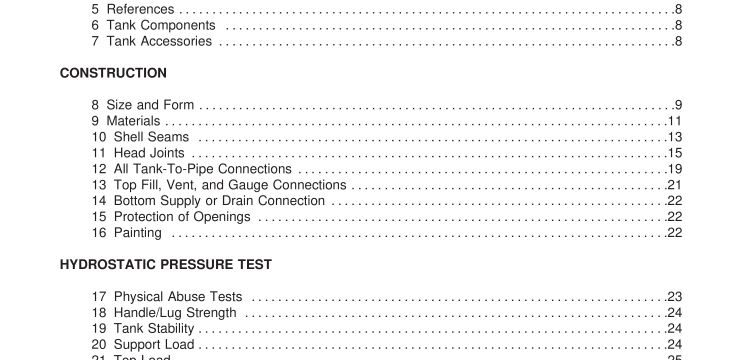UL 80-2007 pdf download.Steel Tanks for Oil-Burner Fuels and Other Combustible Liquids.
3 Glossary 3.1 For the purposes of this Standard, the following definitions apply. 3.2 ABOVEGROUND TANK (also known as ABOVEGROUND STORAGE TANK or AST) – A storage tank that is intended for installation above grade, at grade or below grade without backfill. 3.3 ATMOSPHERIC TANK – A storage tank that has been designed to operate at pressures from atmospheric through a gauge pressure of 1 .0 psig (6.9 kPa) measured at the top of the tank. 3.4 BIO DIESEL – General description of various Class II to IIIB range of long chain fatty acid ester fuels complying with ASTM D6751 processed from vegetable oils or animal fats in pure form (B1 00). Bio diesel may also be blended with heating fuels or diesel fuels (B1 -B99) denoting the percent volume of bio diesel in the mix. 3.5 BOTTOM SUPPLY CONNECTION – A storage tank bottom opening that is intended to provide a means to supply fuel to oil burning equipment or oil to a dispensing device by gravity in addition to providing a means to automatically drain water from the tank. 3.6 DIESEL FUELS – General description of various Class II petroleum distillate grades complying with ASTM D975 including No. 1 and No. 2 Diesel Fuel (also known as on-road diesel, including low sulfur diesel and ultra low sulfur diesel) typically intended for powering compression ignition engines.
3.9 DIKED SECONDARY TANK – An aboveground secondary tank within an open or closed dike intended to provide at least 1 1 0 percent containment capacity of the primary tank or tanks and spill containment. 3.1 0 DOUBLE BOTTOM TANK – A primary tank with an additional bottom capable of being pressurized and has means for venting and monitoring for leaks in the interstitial space, but does not provide complete secondary containment. 3.1 1 HEATING FUELS – General description of various Class II petroleum distillate grades complying with ASTM D395 or ASTM D3699, including No. 1 and No. 2 Fuel Oils or K1 Kerosene (also known as oil burner fuel, including low sulfur distillates and bio diesel blends), typically intended for use in oil burning equipment. 3.1 2 INTERSTITIAL SPACE – The volume between two tank walls that is capable of communicating fluid from a leak in the primary tank to a collection point for purposes of monitoring and venting. 3.1 3 MOTOR OILS – General description of various Class III petroleum distillate or synthetic grades including lube oils, hydraulic oils or transmission oils typically used as lubricating, cooling, or working fluids in motor vehicle applications. 3.1 4 OBROUND – Obround tanks are cylindrical tanks with flat portions of the shell and head on two opposing sides, as shown in Figure 1 2.2. 3.1 5 PERFORMANCE TESTS – A complete evaluation conducted on a limited quantity of representative “worst case” tanks intended to verify compliance with all applicable performance requirements in a Standard. Performance tests are typically destructive. 3.1 6 PRIMARY CONTAINMENT – The ability of an enclosed design or construction to contain a liquid while in normal use without leakage .
3.22 TANK ACCESSORY – Optional devices or components of an aboveground tank intended to provide a specific function, such as venting, heating, load bearing, or special containment. Tank accessories are either integrally connected or field assembled to the tank and may be emergency vents, hot wells, lift lugs, spill containers or other types. 3.23 TANK ORIENTATIONS – General description of the position of an aboveground tank. Horizontal tanks typically are longer and wider than high. Vertical tanks typically are higher than wide. 3.24 TANK SHAPES – General description of the geometry of an aboveground tank. Cylindrical tanks are tubes formed with rolled shells and equivalent circular heads. Rectangular tanks are boxes formed with flat right angled sides. Obround tanks are cylindrical tanks with flat portions of the shell and head on 2 opposing sides. 3.25 TANK SUPPORT – Optional structural members of an aboveground tank intended to bear the weight of, raise above grade and/or stabilize the tank and its contents. Tank supports are integrally connected to the tank by welds, bolts, or threaded pipe, and may be saddle, leg, flat, skid, or other types. 3.26 USED OILS – General description of oils such as those drained from motor vehicles or cooking appliances after use that do not contain water, gas or other contaminants that change the oil Class or may adversely affect the storage tank.UL 80-2007 pdf download.
UL 80-2007 pdf download
